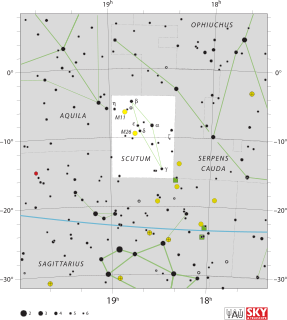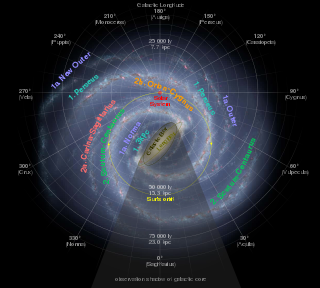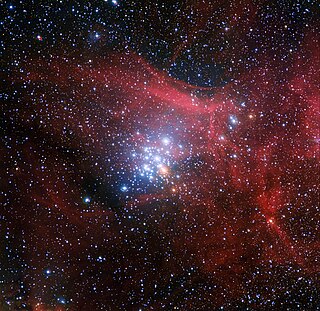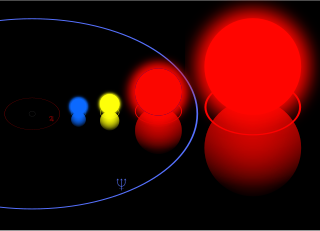Related Research Articles

Scutum is a small constellation. Its name is Latin for shield, and it was originally named Scutum Sobiescianum by Johannes Hevelius in 1684. Located just south of the celestial equator, its four brightest stars form a narrow diamond shape. It is one of the 88 IAU designated constellations defined in 1922.

Red supergiants (RSGs) are stars with a supergiant luminosity class of spectral type K or M. They are the largest stars in the universe in terms of volume, although they are not the most massive or luminous. Betelgeuse and Antares are the brightest and best known red supergiants (RSGs), indeed the only first magnitude red supergiant stars.

The Scutum–Centaurus Arm, also known as Scutum-Crux arm, is a long, diffuse curving streamer of stars, gas and dust that spirals outward from the proximate end of the Milky Way's central bar. The Milky Way has been posited since the 1950s to have four spiral arms — numerous studies contest or nuance this number. In 2008, observations using the Spitzer Space Telescope failed to show the expected density of red clump giants in the direction of the Sagittarius and Norma arms. In January 2014, a 12-year study into the distribution and lifespan of massive stars and a 2013-reporting study of the distribution of masers and open clusters both found corroboratory, though would not state irrefutable, evidence for four principal spiral arms.

NGC 663 is a young open cluster in the constellation of Cassiopeia. It has an estimated 400 stars and spans about a quarter of a degree across the sky. It can reportedly be detected with the unaided eye, although a telescope is recommended for best viewing. The brightest members of the cluster can be viewed with binoculars. Although the listed visual magnitude is 7.1, several observers have reported higher estimates.

A yellow hypergiant (YHG) is a massive star with an extended atmosphere, a spectral class from A to K, and, starting with an initial mass of about 20–60 solar masses, has lost as much as half that mass. They are amongst the most visually luminous stars, with absolute magnitude (MV) around −9, but also one of the rarest, with just 20 known in the Milky Way and six of those in just a single cluster. They are sometimes referred to as cool hypergiants in comparison with O- and B-type stars, and sometimes as warm hypergiants in comparison with red supergiants.

Westerlund 1 is a compact young super star cluster about 2.6 kpc away from Earth. It is thought to be the most massive young star cluster in the Milky Way, and was discovered by Bengt Westerlund in 1961 but remained largely unstudied for many years due to high interstellar absorption in its direction. In the future, it will probably evolve into a globular cluster.

NGC 3293 is an open cluster in the Carina constellation. It was discovered by Nicolas-Louis de Lacaille in 1751. It consists of more than 100 stars brighter than 14th magnitude in a 10 arc minute field, the brightest of which are blue supergiants of apparent magnitude 6.5 and 6.7. There is also a 7th magnitude pulsating red supergiant, V361 Carinae.

S Persei is a red supergiant or hypergiant located near the Double Cluster in Perseus, north of the cluster NGC 869. It is a member of the Perseus OB1 association and one of the largest known stars. If placed in our solar system, its photosphere would engulf the orbit of Jupiter. It is also a semiregular variable, a star whose variations are less regular than those of Mira variables.

A hypergiant (luminosity class 0 or Ia+) is a very rare type of star that has an extremely high luminosity, mass, size and mass loss because of its extreme stellar winds. The term hypergiant is defined as luminosity class 0 (zero) in the MKK system. However, this is rarely seen in literature or in published spectral classifications, except for specific well-defined groups such as the yellow hypergiants, RSG (red supergiants), or blue B(e) supergiants with emission spectra. More commonly, hypergiants are classed as Ia-0 or Ia+, but red supergiants are rarely assigned these spectral classifications. Astronomers are interested in these stars because they relate to understanding stellar evolution, especially star formation, stability, and their expected demise as supernovae.
Alicante 8, also known as RSGC4, is a young massive open cluster belonging to the Milky Way galaxy. It was discovered in 2010 in the 2MASS survey data. As of 2010, the only members of the cluster that are currently identified are 8–13 red supergiants—young massive stars undergoing helium burning in their cores. The cluster is located in the constellation Scutum at the distance of about 20–23 kly (6–7 kpc) from the Sun. It is likely situated at the intersection of the northern end of the Long Bar of the Milky Way and the inner portion of the Scutum–Centaurus Arm—one of the two major spiral arms.
RSGC3 is a young massive open cluster belonging to the Milky Way galaxy. It was discovered in 2010 in the GLIMPSE survey data. The cluster is located in the constellation Scutum at the distance of about 7 kpc from the Sun. It is likely situated at the intersection of the northern end of the Long Bar of the Milky Way and the inner portion of the Scutum–Centaurus Arm—one of its two major spiral arms.

Stephenson 2, also known as RSGC2, is a young massive open cluster belonging to the Milky Way galaxy. It was discovered in 1990 as a cluster of red supergiants in a photographic, deep infrared survey by the astronomer Charles Bruce Stephenson, after whom the cluster is named. It is located in the constellation Scutum at the distance of about 6 kpc from the Sun. It is likely situated at the intersection of the northern end of the Long Bar of the Milky Way and the inner portion of the Scutum–Centaurus Arm—one of the two major spiral arms.

NGC 7419 is an open cluster in the constellation Cepheus. It is heavily reddened and notable for containing five red supergiants, the highest number known in any cluster until the end of the 20th century, but probably no blue supergiants.

Stephenson 2-18, also known as Stephenson 2 DFK 1 or RSGC2-18, is a red supergiant (RSG) or possible extreme red hypergiant (RHG) star in the constellation of Scutum. It lies near the open cluster Stephenson 2, which is located about 5.8 kiloparsecs away from Earth in the Scutum–Centaurus Arm of the Milky Way galaxy, and is assumed to be one of a group of stars at a similar distance, although some sources consider it to be an unrelated or foreground red supergiant. It is among the largest known stars, one of the most luminous red supergiants, and one of the most luminous stars in the Milky Way.

RSGC1-F01 is a red supergiant located in the RSGC1 open cluster in the constellation of Scutum. The radius was calculated to be around 1,530 times that of the Sun, making it one of the largest stars discovered so far. This corresponds to a volume 3.58 billion times bigger than the Sun. If placed at the center of the Solar System, the photosphere would engulf the orbit of Jupiter.

Trumpler 27-1 is a red supergiant star that is a member of the massive, possible open cluster Trumpler-27, where a blue giant star, a yellow supergiant star, and two Wolf–Rayet stars are also located.
Alicante 10, also known as RSGC6, is a young massive open cluster belonging to the Milky Way galaxy. It was discovered in 2012 in the 2MASS survey data. Currently, eight red supergiants have been identified in this cluster. Alicante 10 is located in the constellation Scutum at the distance of about 6000 pc from the Sun. It is likely situated at the intersection of the northern end of the Long Bar of the Milky Way and the inner portion of the Scutum–Centaurus Arm—one of the two major spiral arms.
Stephenson 2 DFK 49 or Stephenson 2-11 is a putative post red supergiant star in the constellation Scutum, in the massive open cluster Stephenson 2. It is possibly one of the largest known stars with radius estimates ranging from almost 1,000 solar radii to 1,300 solar radii. If the upper estimate is correct, then Stephenson 2 DFK 49 has a volume 2.2 billion times that of the Sun. If it was placed at the center of the Solar System, its photosphere will potentially approach or engulf Jupiter's orbit.
References
- 1 2 "Cl Alicante 7". SIMBAD . Centre de données astronomiques de Strasbourg . Retrieved 2020-10-05.
- 1 2 3 4 Negueruela, I.; González-Fernández, C.; Marco, A.; Clark, J. S. (1 April 2011). "A massive association around the obscured open cluster RSGC3". Astronomy & Astrophysics. 528: A59. arXiv: 1102.0028 . Bibcode:2011A&A...528A..59N. doi:10.1051/0004-6361/201016102. S2CID 53517711.
- ↑ Origlia, L.; Dalessandro, E.; Sanna, N.; Mucciarelli, A.; Oliva, E.; Cescutti, G.; Rainer, M.; Bragaglia, A.; Bono, G. (2019). "Stellar population astrophysics (SPA) with the TNG". Astronomy & Astrophysics. 629: A117. arXiv: 1908.07779 . doi:10.1051/0004-6361/201936283. S2CID 201125229.